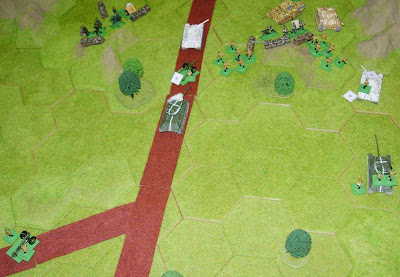I have a campaign map, I have the forces I am going to use, and I have a draft set of tabletop rules for my mini-campaign; what I did not have was a set of campaign rules ... but these have now been drafted.
The bulk of the rules are based on those laid down in THE PORTABLE COLONIAL WARGAME, but with a few additions and changes.
Firstly, I have included the weather charts I designed back in June as well as factoring in the impact that the seasons and weather will have on campaign movement.
Secondly, I am going to allow formations to move from one grid square to another through the corners of grid squares that are not occupied by enemy formations as well as through the faces of the grid squares.
Thirdly, I have added a casualty recovery mechanism that works as follows:
The bulk of the rules are based on those laid down in THE PORTABLE COLONIAL WARGAME, but with a few additions and changes.
Firstly, I have included the weather charts I designed back in June as well as factoring in the impact that the seasons and weather will have on campaign movement.
Secondly, I am going to allow formations to move from one grid square to another through the corners of grid squares that are not occupied by enemy formations as well as through the faces of the grid squares.
Thirdly, I have added a casualty recovery mechanism that works as follows:
- 33% of all lost SPs lost by a formation during a battle are recovered immediately after the battle has ended.
- 33% of all lost SPs lost by a formation during a battle are recovered to the Central Reserve D6 turns after the battle has ended.
- The remaining SPs lost by a formation during a battle are lost for the rest of the campaign.
- The SPs lost by a formation during a battle can be recovered immediately after the battle has ended from the Central Reserve if there are sufficient SPs available in the Central Reserve. (NB. The Central Reserve is a pool of SPs generated by recovered battle casualties and newly raised SPs. I have yet to determine how the latter will work.)































































.jpeg)









